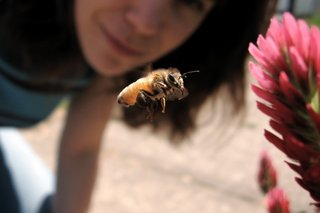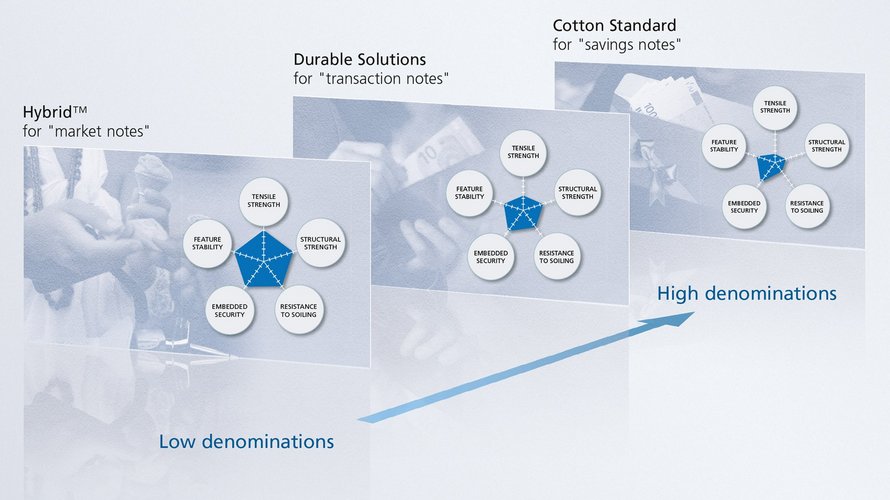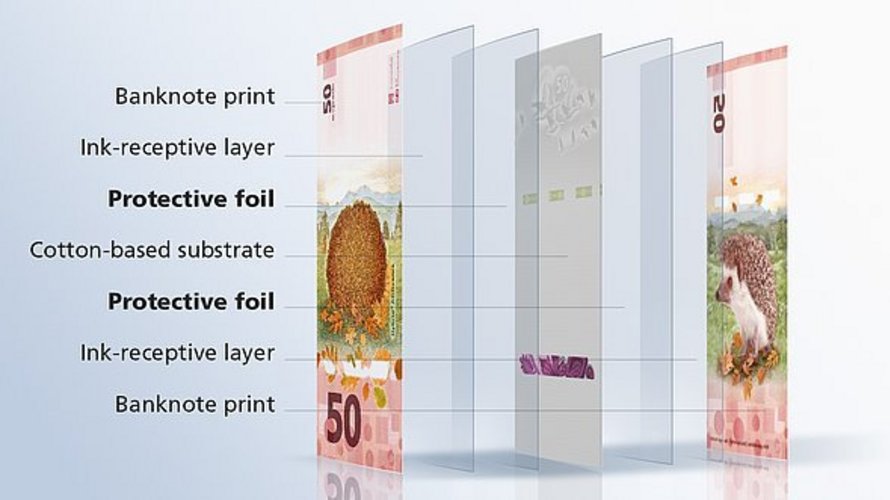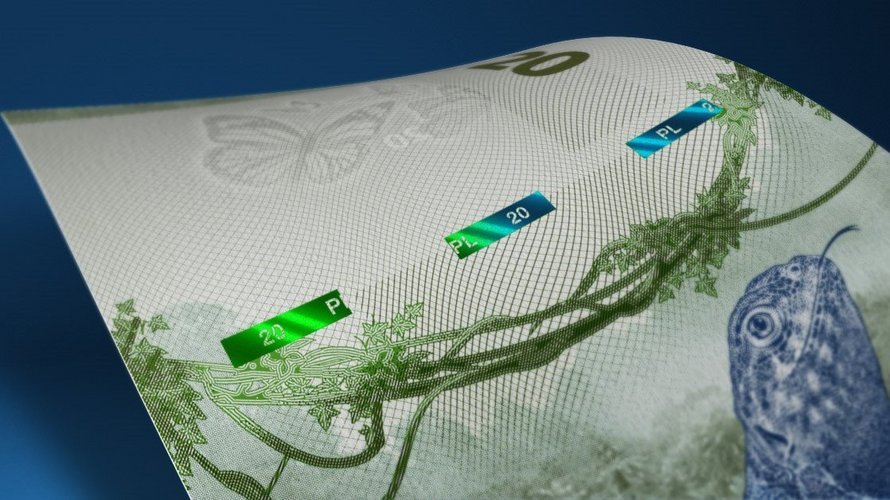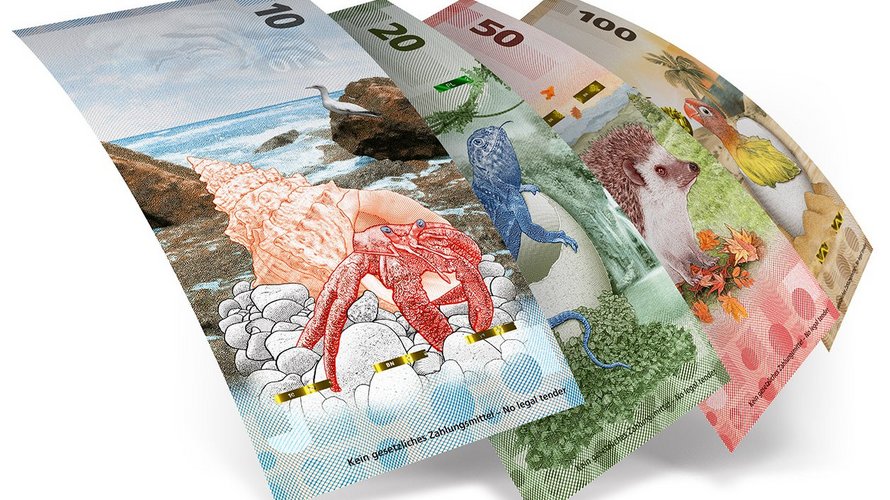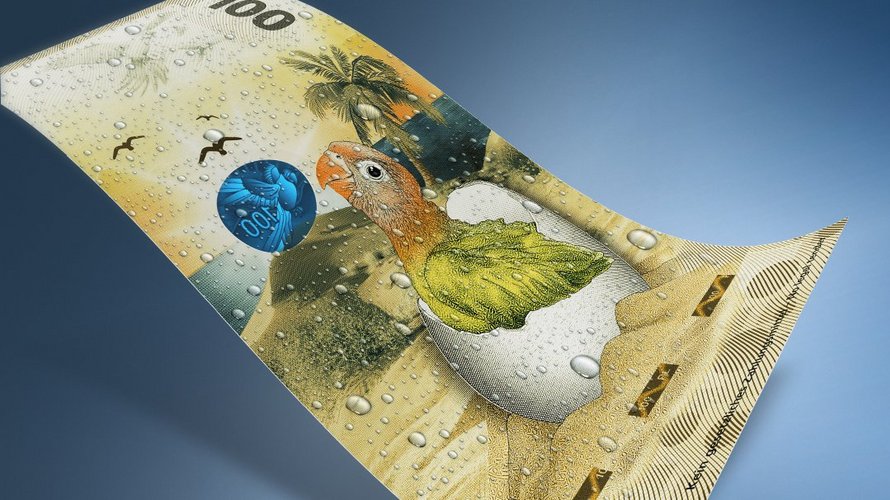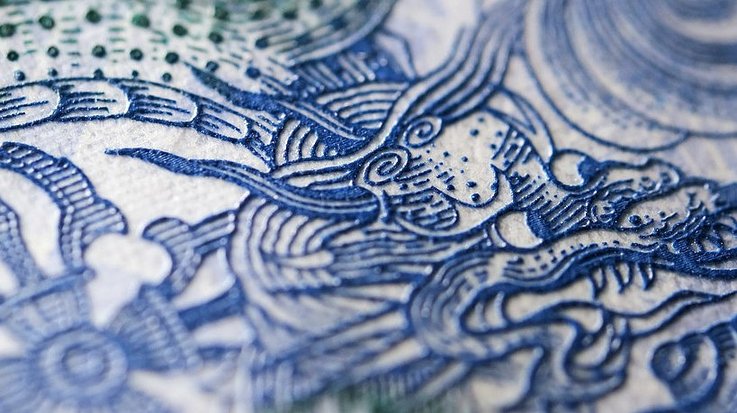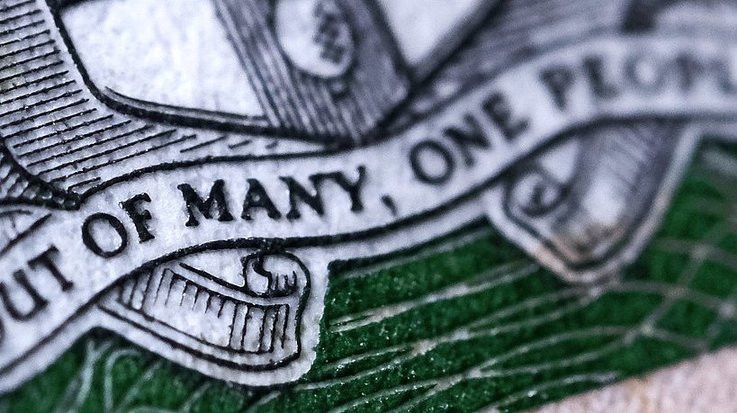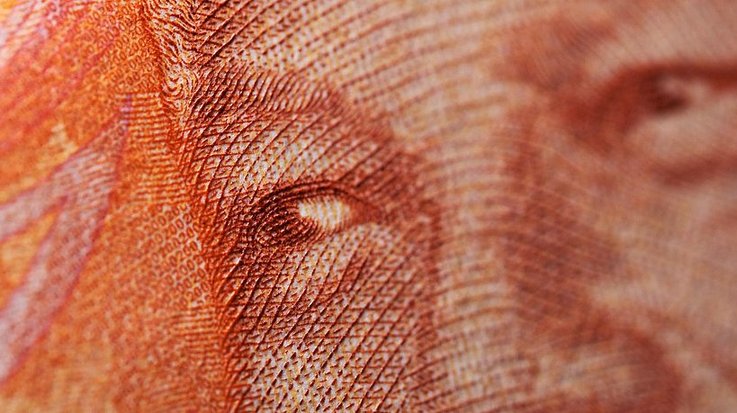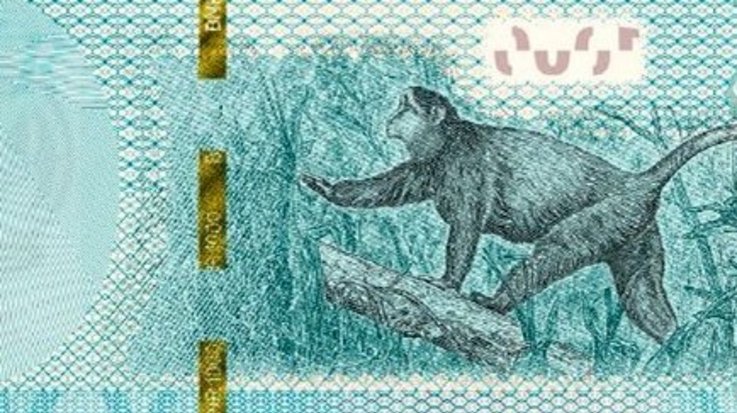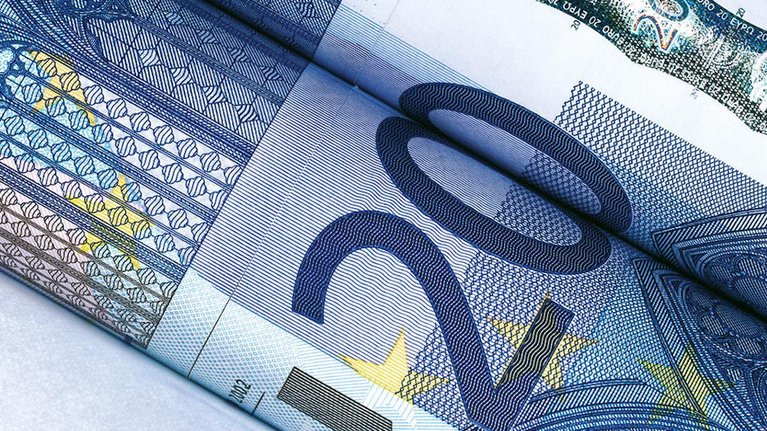
Banknote paper: long-lasting, for secure and attractive banknotes
Banknote longevity is affected by conditions in circulation, including soiling, heat, moisture, and mechanical stress. We offer scalable substrate solutions that meet the diverse requirements of each country. We use proven processes to develop optimized substrates that are dirt-repellent, durable, and at the same time compatible with all security features, so banknotes are secure, fit and in circulation for longer.
We have been producing banknotes for almost 170 years, and we use this experience to develop scalable banknote substrates that meet exacting requirements. Our scalable portfolio offers appropriate substrates for low (market notes), medium (transaction notes) and high nominal values (saving notes) within a series. These substrates strengthen banknotes against daily stresses, and extend their time in circulation. For currencies that circulate under extreme climatic conditions, our banknote paper is treated with lacquers or plastic lamination, making it durable – dirt, water, and mechanical stress are minimised. This is particularly important, for lower denominations that are frequently handled and subject to a greater risk of soiling. We therefore support central banks in implementing their Clean Note Policy.
Whichever substrate is used, the banknote paper itself ensures reliable counterfeit protection. Visible and hidden security features are part of the package . These are embedded into the substrate, attached to it, or printed on it. Our substrates are compatible with all security features, so central banks choose, based on a modular system of security elements, depending on the counterfeit risk of a note.
Banknote substrates at a glance
- Secure and publically acceptable
- Scalable product range with uniform appearance and identical tactile properties in all substrate versions
- Long-lasting and functional solutions
- Reliable machine processing in banknote processing systems
Hybrid ADDvance®
Make less plastic work. With unmatched security from within.
The demands on banknotes are not only growing in terms of security and design; efficiency and sustainability are factors against which modern banknotes must be measured. A decisive factor here is the durability of the notes in the cash cycle – the longer a banknote lasts, even under difficult circulation conditions, the later it has to be replaced by a new one. One answer to this circumstance is polymer banknotes, which indisputably have a better durability than pure cotton notes. However, in return, these notes show disadvantages in terms of security. And compromising on security simply does not work. With Hybrid ADDvance® we have found a way to make less plastic work for more security, more durability, and more sustainability at the same time.
The answer to the question of a modern banknote that meets all the demands placed on it is indeed highly complex. With Hybrid ADDvance® we have a high-tech banknote substrate in our portfolio that is multi-layered in the truest sense.
An ultra-thin film of polymer protects a cotton core in which all important security features such as watermark, thread, optically variable stripe, or patch up to machine-readable elements can be embedded.
Your benefits at a glance
- Substrate-embedded security technology for maximum security
- Super-durable features for demanding circulation conditions
- Sustainability at its best
- Optimum machine readability and processing
- Touch and feel of cotton banknotes
An ultra-thin film of polymer protects your investment in the security features of your banknotes.
The cotton core of Hybrid ADDvance®, which makes uncompromising security possible in the first place by embedding the security features, is a by-product of the textile industry. A recycled product, so to speak. And yet the special sustainable benefit of this innovative substrate begins here. Through the intelligent use of only a minimal amount of polymer as a protective film, only extremely little plastic is needed to take full advantage of its positive characteristics.
Hybrid ADDvance® proves that sustainability, efficiency, and durability can be increased without compromising security. It goes without saying that Hybrid ADDvance® banknotes are no different from proven cotton banknotes either in terms of day-to-day handling or machine processability, and this is due to the demands we place on modern banknotes.
Green Banknote
A banknote that pays off for the environment
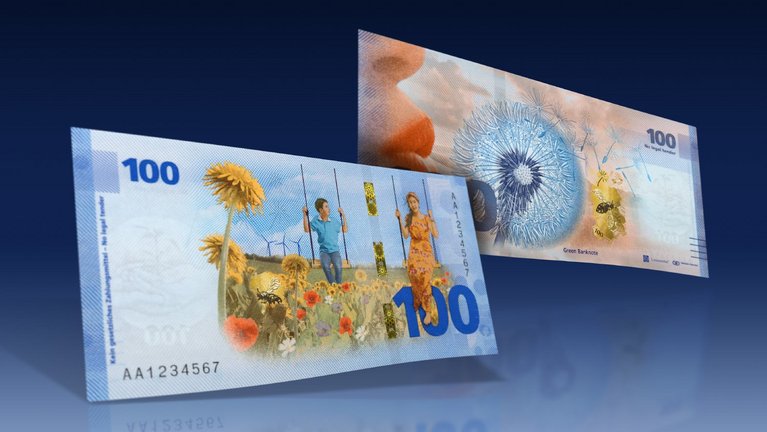
Our award-winning solution for greater sustainability is the Green Banknote, awarded with the IACA Award 2023 for Best New Environmental Sustainability Program For Currency — a Hybrid ADDvance® banknote with the lowest carbon footprint but with no compromise on durability and security.
Using certified processes and sustainable materials, we focus on reducing carbon emissions, use of virgin plastics, plastic content, and water consumption – while still achieving maximum confidence through security from within. With a durability three times higher than standard cotton, 38% less virgin plastic for the finished banknote than previous hybrid substrates and 63% less CO2 emissions than conventional cotton fibers, the Green Banknote minimizes a currency’s footprint significantly.
Advantages of the Green Banknote:
- Less plastic is used
- Less CO2 emissions
- Less water consumption
- Highest security standards
- Highest durability
- Full public acceptance
Hybrid banknote paper
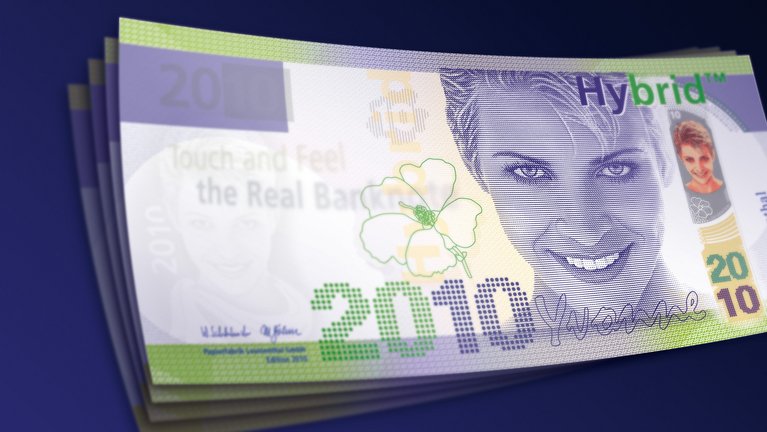
Hybrid banknotes are an innovation in banknote technology and offer the best of both worlds. They are based on a cotton substrate which is covered with polyester foils on both sides, protecting the substrate. This makes Hybrid banknote paper durable, robust and highly resistant to soiling. In addition, banknotes featuring a Hybrid substrate feel familiar, just like banknotes made from cotton paper, while still offering the high protection against counterfeiting. Hybrid banknotes are strongly recommended for countries with challenging climatic conditions.
- Extremely robust and durable, even under extreme conditions
- Excellent counterfeit protection, as all state-of-the-art security features can be integrated
- Can be printed as per cotton banknote paper
- The familiar trusted feel of cotton banknotes
- Well-suited for market notes with a low value in challenging circulation condition
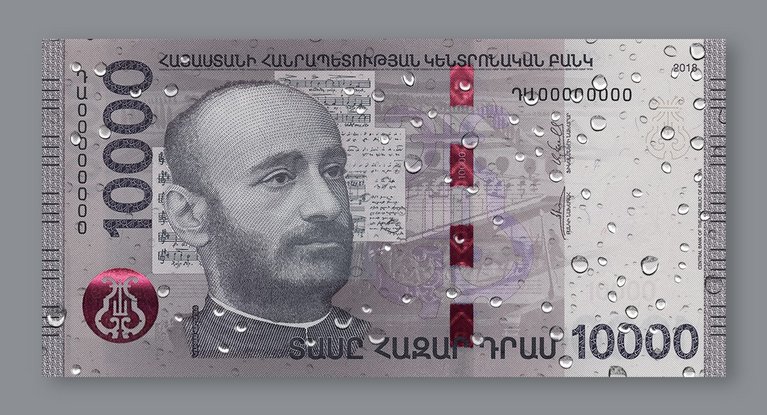
LongLife™ durable paper
LongLife™ banknote paper increases the circulation life of banknotes. This substrate’s core is cotton paper, and it is coated with a special lacquer, applied in a microscopically thin layer. This repels dirt and moisture, extending the life of the banknotes in circulation, particularly in tropical climates. This solution is especially suitable for nominal values subject to heavy use. In addition, the LongLife™ banknote paper look and feel is almost indistinguishable from regular cotton banknotes. This ensures public acceptance with no costly publicity campaign.
- The special coating provides effective protection against soiling and humidity.
- Circulation life is extended by up to 200% making them cost effective.
- The banknote has the identical printing process to cotton paper.
- LongLife banknote paper provides a high barrier to counterfeits due to tamper-proof embedded security features.
- It is very well-suited to frequently used mid-range transaction notes.
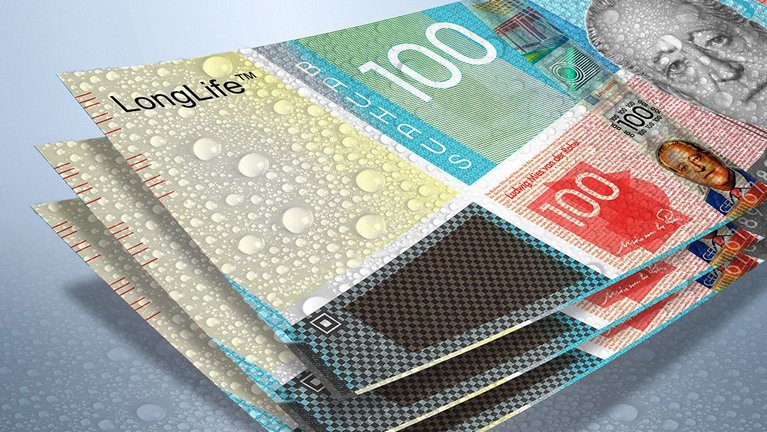
Green LongLife™ durable paper
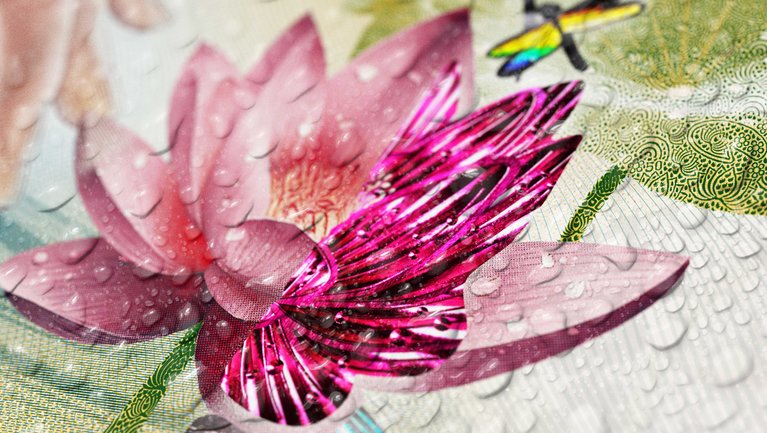
A more sustainable cash cycle is the goal of every central bank – and as a leading provider of banknotes based on natural renewable fibers, we are constantly working to improve all our products and make them even more sustainable.
With Green LongLife™, we have succeeded in further increasing the amount of renewable raw materials in a particularly durable banknote substrate. At the same time, we reduced the content of mineral oil-based materials such as plastic to an absolute minimum and opted for mineral oil-free inks. With Green LongLife™, we have retained the well-known strengths – and decisively improved sustainability once again.
Alternative fibers such as organic cotton or Cotton made in Africa (CmiA) can be selected for substrate production. The Galaxy® security thread and RollingStar® LEAD Mix film now use 70% recycled polyester, and the biobased carbon content is > 85%.
Green LongLife™ delivers unmatched security from within, offering the possibility of being protected with the most advanced security features.
Advantages of Green LongLife™:
- High biobased carbon content by using natural fibers
- Pre-coating based on natural raw materials
- Mineral oil-free inks
- Reduced carbon emissions with the use of certified organic cotton
- High durability achieving up to 2x lifetime compared to standard banknotes
- Unmatched security from within utilizing substrate-embedded L1, L2 and L3 features
- Numerous possibilities for repurposing – from Banknote Fiber Extraction to composting and plenty more
Cotton banknote paper
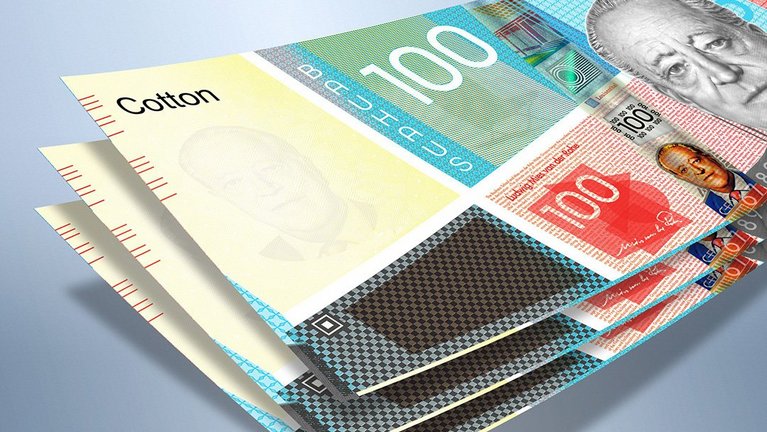
The majority of banknotes globally are made from traditional cotton paper. Central banks have relied on the proven properties of cotton for decades. The look, specific tactile feel, and “sound” of new, crisp notes is trusted. In addition, cotton paper is ideal for the integration of tested and innovative security features, while watermarks, security threads and foils ensure that the notes’ value is protected.
- Banknote paper made from cotton is cost-effective and presents the foundation for high print quality and production efficiency.
- Visible and invisible security features can be embedded for optimum counterfeit protection.
- Cotton banknotes have a familiar look and feel.
- Cotton banknotes are well-suited for high denomination savings notes.
References
Get in touch
If you have any questions about our end-to-end business solutions or about our SecurityTech company, seek expert advice, or want to give us your feedback, our team is here to support you, anytime.



